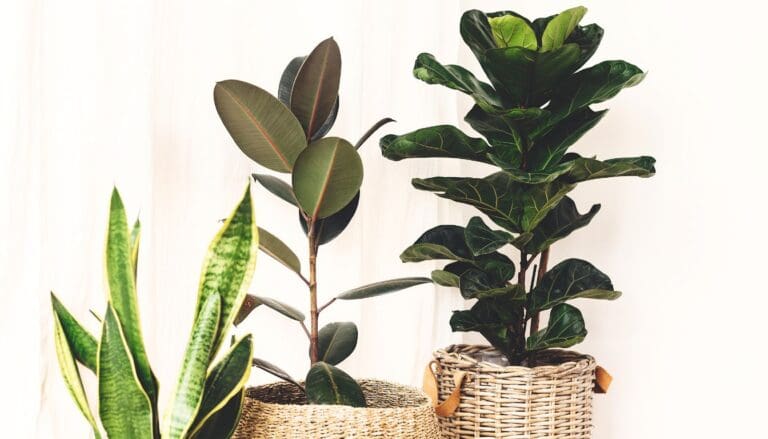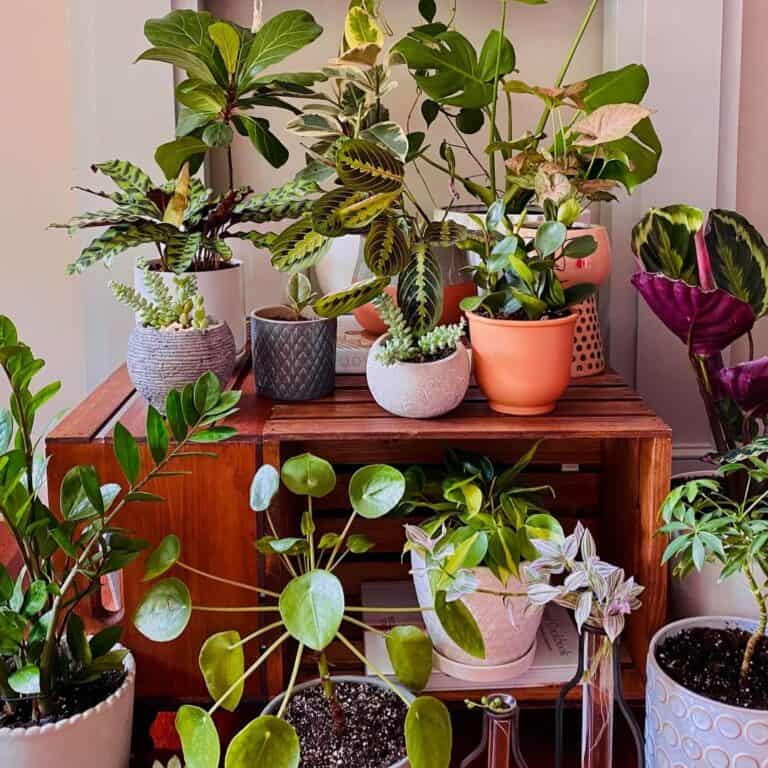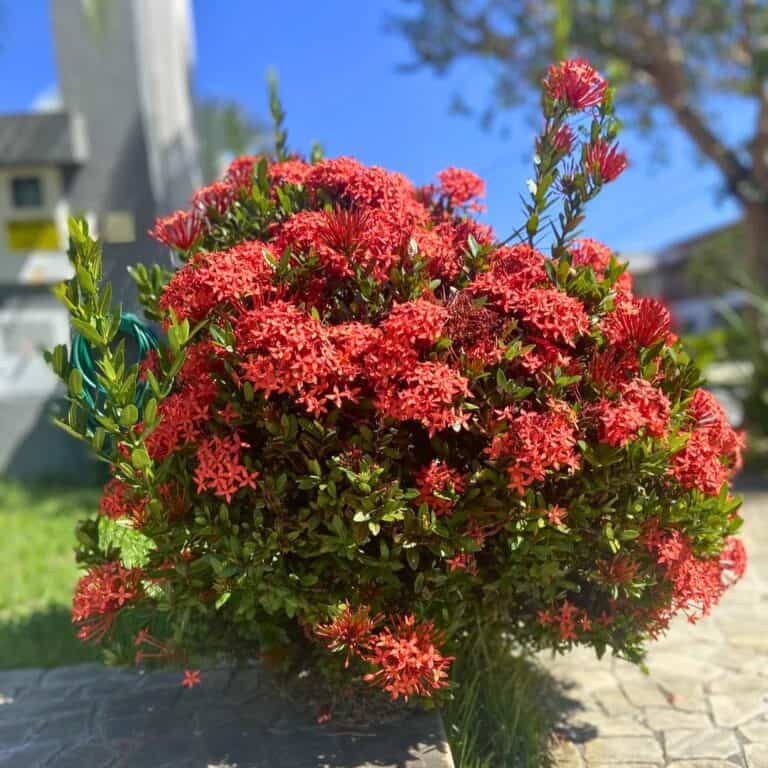15 Full Sun Flower Bed Ideas To Beautify Your Front Yard
There’s just something about a bright flower bed—it instantly lifts the whole vibe of a front yard.
When the sun’s shining all day, it’s the perfect excuse to go wild with bold, colorful blooms that really grab attention.
A full sun flower bed brings beauty, texture, and a little extra life to your home’s entrance.
Here, I’m sharing ideas for making the most of those sunny spots. From picking the right flowers to adding simple touches for charm and balance, each idea is about creating a front yard that feels fresh, natural, and honestly, just easy to enjoy.
Please note: Simplify Plants is reader-supported. As an Amazon Associate, I earn from qualifying purchases made by our readers with no extra cost added to you all! Some links in the post are affiliate links and I get a commission from purchases made through links in the post.
1) Choose vibrant sunflowers like ‘Autumn Beauty’ for a colorful display
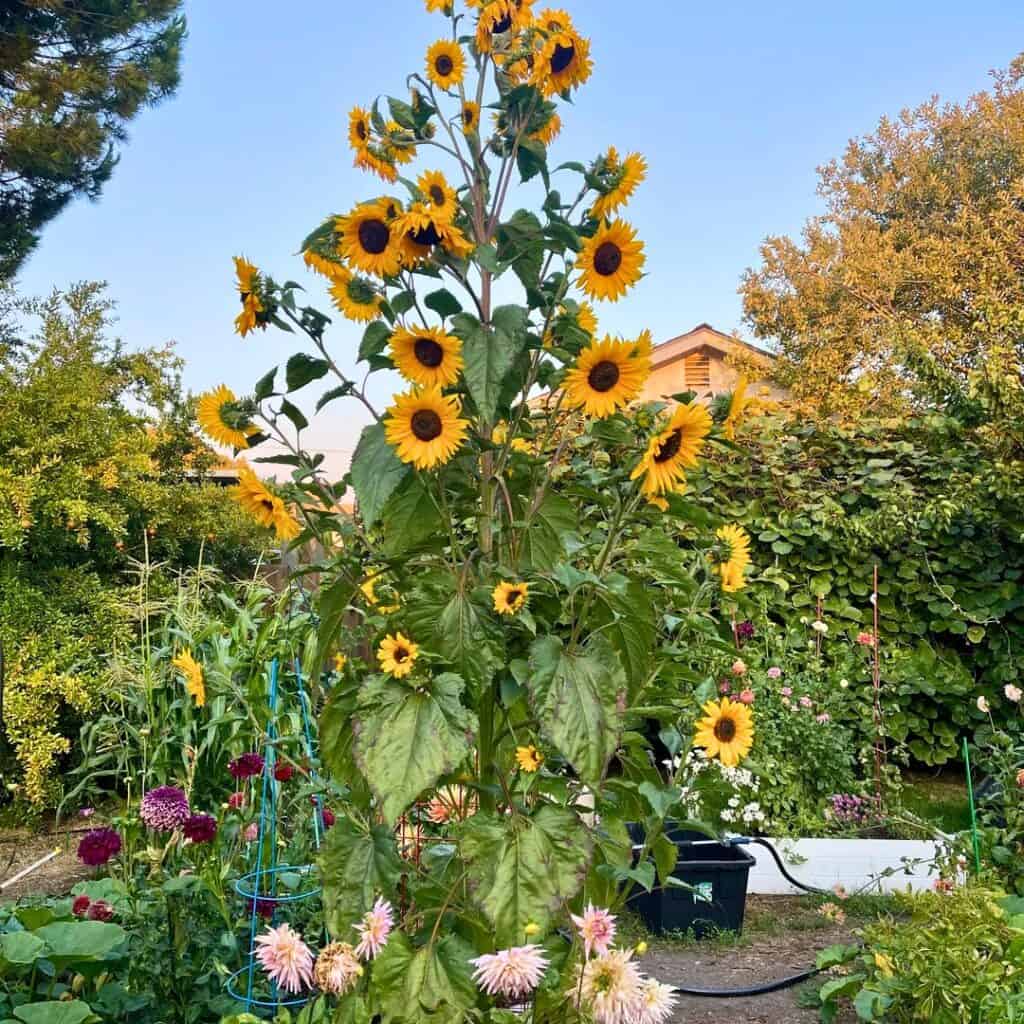
I’m a huge fan of ‘Autumn Beauty’ sunflowers—they fill my yard with warm yellows, oranges, and reds. These colors just pop in full sunlight and make my flower bed look cheerful all season.
These sunflowers grow tall and sturdy if you plant them in well-drained soil and give them a bit of space. Each stem throws out several blooms, so the bed looks full and lively without too much fuss.
To keep the colors looking their best, I water regularly but never overdo it. Too much water? That’s just asking for root problems. I always check the soil before adding more.
Mixing in ‘Autumn Beauty’ with shorter flowers like zinnias or marigolds is a favorite trick of mine. The height difference creates layers, making the sunflowers stand out even more.
When the flowers start to fade, I leave some seed heads for the birds. Watching them swoop in is half the fun, and it helps the plants reseed for next year.
I trim damaged leaves and pull weeds whenever I can. A tidy bed really lets those colors shine and keeps the space looking inviting.
These sunflowers attract bees and butterflies, which is great for pollinating the rest of my garden. Supporting local wildlife while making the yard beautiful? Win-win.
If I’m after a longer bloom time, I’ll plant seeds every couple weeks in early summer. That way, new flowers keep popping up as the older ones fade.
With just a bit of care, ‘Autumn Beauty’ sunflowers bring lasting color and life to my front yard. They’re such an easy way to create a bright, welcoming space that soaks up every bit of sunshine.
2) Plant sunflowers in a curved bed to soften hard edges

A curved flower bed can totally change how my yard feels. Straight lines sometimes make things feel too rigid, but soft curves add a nice sense of movement and balance.
When I plant sunflowers along a gentle curve, it naturally draws the eye across the garden. The shape really helps blend the edges of driveways, walkways, or fences.
Tall blooms break up sharp corners and make the area way more inviting. Plus, the curve kind of tricks the eye into thinking the yard is bigger.
I like mixing different sunflower varieties for height and color variation. Short ones in front, tall ones in the back—simple, but it really works.
Before planting, I lay out a garden hose to mark the curve and see how it looks from different spots. Once I’m happy with it, I’ll outline the bed with edging or stones.
Sunflowers need full sun and well-drained soil, so I make sure the bed gets at least six hours of sun. I water deeply once a week to help the roots grow strong.
A bit of mulch around the base helps keep moisture in and weeds out. I like natural wood mulch since it looks good with those bright yellow petals.
When the sunflowers bloom, the curved bed becomes a cheerful focal point. That arc of golden faces really softens the hard edges and adds a warm, welcoming touch.
3) Mix sunflowers with purple coneflowers for contrast

There’s just something about sunflowers and purple coneflowers together. The bright yellows next to those deep purples? It’s a color combo that always gets noticed.
Both thrive in full sun and handle heat, so they’re super easy to grow side by side. I plant them in well-drained soil, water regularly until they settle in, and then just deadhead when needed.
Taller sunflowers go in the back, with coneflowers up front. That keeps things balanced and lets every flower catch the light.
Pollinators love this mix. Bees and butterflies are all over both plants all summer, and goldfinches love the dried coneflower seeds later on.
Grouping the flowers in small clusters instead of rows gives a more relaxed, natural look. Sometimes I’ll add a few ornamental grasses between clusters for extra texture.
If I want a longer bloom season, I pick different sunflower varieties that flower at different times. The coneflowers keep their shape even after blooming, so there’s always something interesting going on.
Mixing these two makes my front yard lively but not crowded. It’s low-maintenance, easy for anyone to try, and honestly, yellow and purple together just makes me happy every time I walk outside.
4) Add marigolds around sunflowers to deter pests naturally

I like planting marigolds around my sunflowers—they’re a simple, natural way to keep pests away. Their strong scent can discourage insects like aphids and beetles that might go after sunflower leaves or stems.
The orange and yellow marigolds at the base of tall sunflowers create a cheerful contrast and make the whole bed pop from the street.
I’ve noticed marigolds also attract beneficial insects like ladybugs and bees, which help with pollination and pest control.
I plant marigolds in a circle or border around the sunflowers. This forms a natural barrier that pests don’t seem to love crossing.
Both flowers want full sun and well-drained soil, so they grow well together. I water regularly and deadhead the marigolds to keep them blooming.
It doesn’t take much effort, but adding marigolds makes a big difference. The mix of height, color, and natural pest control keeps my sunflower bed lively and easy to care for.
5) Use decorative garden stakes to add charm
Decorative garden stakes are just fun, honestly. They make my flower bed feel more personal and lively, and there are so many styles to choose from.
I’ll tuck a few metal or wooden stakes among the flowers to break up the greenery. Simple shapes like butterflies or birds add a cheerful touch without stealing the spotlight.
If I’m feeling fancy, I’ll use solar-powered stakes that light up at night. The soft glow makes the flowers look magical after sunset.
Mixing different heights and colors keeps things balanced. Tall ones in the back, short ones up front—it’s a quick way to fill any gaps.
I like to swap out seasonal or themed designs—pumpkins for fall, stars for summer. Little changes like that keep the garden interesting all year.
I always check that the stakes are weather-resistant so they’ll last through rain and sun. A quick wipe down every now and then keeps them looking good.
Adding garden stakes is just a simple way to show a bit of personality and make my flower bed stand out. They turn a simple space into something that feels creative and welcoming.
6) Incorporate ornamental grasses for texture

Ornamental grasses are kind of underrated in flower beds, if you ask me. They bring movement and texture that flowers alone just can’t.
Their tall, airy blades make the space feel natural and balanced. When I mix grasses with bright blooms, the contrast is striking.
The soft greens and golds of the grasses help the flower colors look even stronger. It’s such an easy way to add layers and interest.
I like planting fountain grass, blue fescue, or maiden grass in sunny spots. They handle heat well and stay good-looking all season.
Their feathery tops sway in the wind, which adds a calm, lively feel to the yard. I usually group grasses in small clusters or use them as borders to define the edges.
A yearly trim keeps them tidy and encourages fresh growth. Mixing heights makes a big difference—taller grasses in the back, shorter ones in front, so the bed doesn’t look flat.
A few types of grasses keep the garden interesting all year. Even when the flowers fade, the grasses stay pretty much the same, so my front yard never feels empty.
Most ornamental grasses are drought-tolerant and don’t need much fertilizer. Once they’re in, they’re basically set-and-forget, which I appreciate.
When I pick grasses, I think about how they’ll look with my flowers. Fine, wispy grasses next to big blooms like sunflowers or coneflowers keep things from feeling too uniform.
In full sun, ornamental grasses really thrive and help nearby plants shine. They fill out the garden without overcrowding, and I love how they bring a simple, natural charm to the whole front yard.
7) Plant sunflowers in raised beds for better soil control
I’m a big fan of raised beds because they let me really dial in the soil. Sunflowers are happiest in soil that drains well but doesn’t dry out too fast.
With a raised bed, it’s easy to tweak the mix until it feels just right. I usually go for a blend of garden soil, compost, and a bit of sand.
That combo keeps things light and packed with nutrients. Plus, water doesn’t pool up around the roots, so the plants stay healthier.
Raised beds warm up quicker in the spring, which means I get to plant sunflower seeds earlier. Blooms come sooner, and honestly, I just like getting a jump on things.
Weeds don’t seem to take over as fast, either. The contained space makes it easier to keep them in check.
I always make sure each bed gets at least six to eight hours of sunlight a day. Sunflowers are total sun-lovers, and raised beds make it simple to move them to the brightest spot.
Sometimes the extra height leaves tall sunflowers a bit exposed to wind. I’ll add stakes or supports when needed so they don’t flop over.
Another bonus: raised beds just look tidy and add some structure. The neat edges and tall blooms make my front yard feel cheerful and put together.
I like to water in the morning so the soil can dry out through the day. Raised beds dry out faster than ground soil, so I check the moisture pretty often.
Mixing different sunflower types in one bed is fun, too. Shorter varieties go up front, taller ones in the back—gives the whole thing some depth and keeps it interesting.
The best part? Raised beds make it so much easier to care for my plants without all the bending. I can reach every corner, weed quickly, and spot pests before they’re a problem.
It’s simple, tidy, and honestly, really satisfying.
8) Create a sunflower border along your walkway
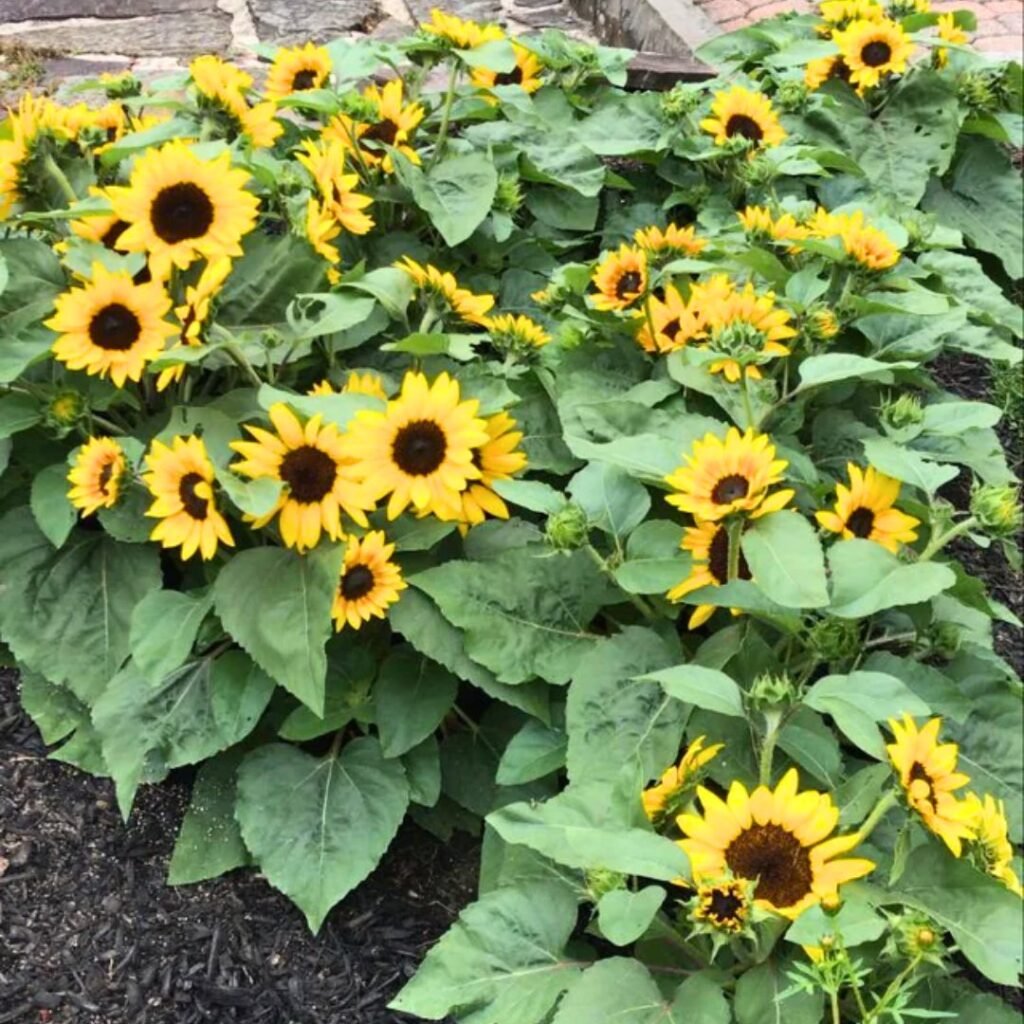
There’s just something about sunflowers lining a walkway—they brighten up the path and make the entrance feel so much friendlier. Their tall stems and big, golden faces are like a natural welcome sign.
I usually pick dwarf or medium-height sunflower varieties for the border. That way, they don’t block the walkway but still bring plenty of color.
Spacing matters, too. I leave enough room between each plant for airflow and healthy growth.
To keep things looking full but not crowded, I’ll mix in low-growing plants like marigolds or zinnias. They fill gaps and add a splash of color closer to the ground.
It’s important the walkway gets at least six to eight hours of sunlight each day. Sunflowers need that much sun to really thrive.
Instead of watering lightly every day, I prefer to water deeply a few times a week. It seems to work better for them.
Adding mulch around the base helps hold in moisture and keeps weeds from taking over. I like using natural mulch that blends right in with the soil.
When the flowers start to fade, I’ll snip off the old blooms to keep things looking fresh. Sometimes I leave a few seed heads for the birds—they always show up for a snack.
A sunflower border is such a simple way to make a walkway feel warm and inviting. It’s easy to care for, and every time I walk by, it just makes me happy.
9) Combine sunflowers with zinnias for a bright summer look
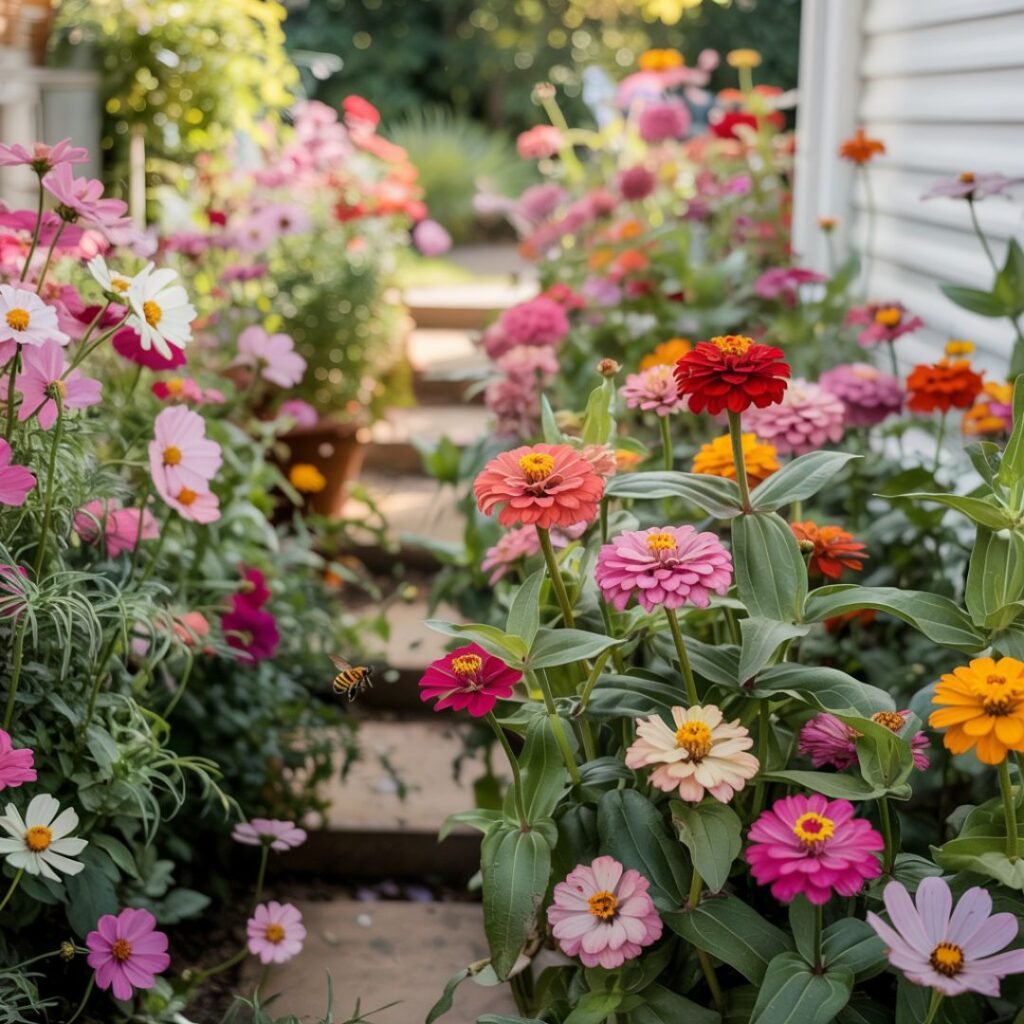
I can’t get enough of how sunflowers and zinnias brighten up my yard. Both love full sun and deliver bold color that lasts, even on the hottest days.
When I plant them together, the space feels a lot more lively. I usually tuck tall sunflowers in the back—they make a great backdrop and give everything some structure.
In front, I’ll plant zinnias in all sorts of colors. They fill out the bed and layer in more blooms.
Zinnias are fast growers and they bloom for ages, so the bed always looks fresh. I like how their smaller flowers balance out the big sunflower heads.
The mix of shapes and colors keeps the garden feeling full without getting messy. I plant both in well-drained soil and make sure to water regularly, especially if it’s hot and dry.
A thin layer of mulch helps keep the soil cool and cuts down on weeds. For color, I lean toward zinnias in pink, orange, and red—they pop against the sunflowers’ yellow.
That color contrast really catches the eye and gives off such a fun summer vibe. I’ll cut a few stems sometimes; sunflowers and zinnias make awesome cut flowers and last several days indoors.
This combo works just about anywhere—along fences, by the walkway, or near the porch. The flowers attract bees and butterflies, which always makes the space feel more alive.
Watching pollinators bounce from bloom to bloom is a treat. When I want a low-maintenance but colorful garden, this pairing never lets me down.
With a bit of care and plenty of sun, sunflowers and zinnias turn my front yard into a bright and happy summer spot.
10) Use mulch to retain moisture and keep weeds down

I always toss down mulch after planting because it helps the soil stay moist longer. The sun dries out the ground fast, but mulch keeps the water where it belongs.
It also gives the flower bed a tidy, finished look. I prefer organic mulch like shredded bark, wood chips, or compost.
These break down slowly and improve the soil as they go. Plus, they blend right in with the rest of the garden.
A 2- to 3-inch layer seems to work best. It’s thick enough to block sunlight from weed seeds, which means fewer weeds for me to pull.
More time to enjoy the flowers, less time weeding—can’t argue with that. I always keep mulch a few inches away from plant stems so there’s no rot and air can circulate.
It’s a little thing, but it really helps keep plants healthy. Mulch also helps regulate soil temperature—cooler roots on hot days, warmer roots when it cools off at night.
Flowers handle weather swings a lot better with mulch in place. I refresh the mulch once or twice a year, usually just a quick top-up in spring or early summer.
It’s such an easy step, but it makes a big difference for both the look and health of my beds. Mulch saves water, cuts down on chores, and keeps my full sun flower bed looking good all season.
11) Add solar garden lights to highlight sunflowers at night
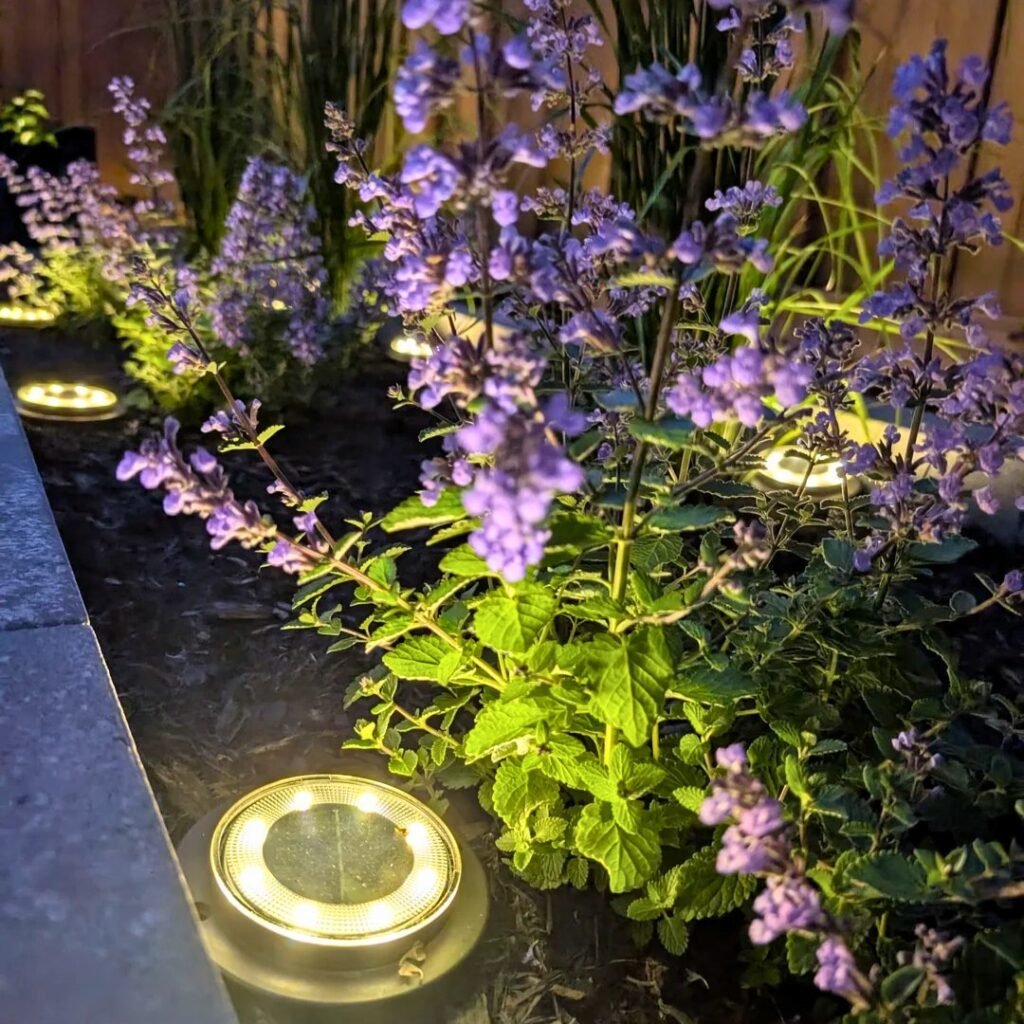
There’s something magical about solar garden lights in a sunflower bed after dark. They soak up sunlight all day and switch on by themselves at night.
No electricity needed, which is always a plus. I line the edge of the bed with lights to outline the shape of my sunflowers.
The gentle glow shows off their tall stems and golden petals, and the yard just feels more welcoming in the evening. I always go for warm white lights—they give a soft, natural glow that flatters the flowers.
Cool white lights can look a bit harsh, so I skip those. The warm tone makes the sunflowers’ yellow pop even more.
I make sure the solar panels get full sun during the day. If a plant grows and starts to shade them, I’ll move the lights so they keep charging.
Some lights come with stakes or fun shapes. I like little lantern-style ones for a cozy vibe, but modern spotlights work too if that’s more your style.
For walkways, I use motion-sensor solar lights. They pop on when someone walks by, which is handy and saves battery.
When I have friends over in the evening, the lights make everything feel calm and a bit magical. Guests can still see the flowers, and the space just feels more inviting.
Setting up solar lights is honestly easy—just stick them in the ground and let the sun do the work. It’s one of the simplest ways to show off my sunflowers day and night.
12) Include bee-friendly plants nearby to encourage pollination
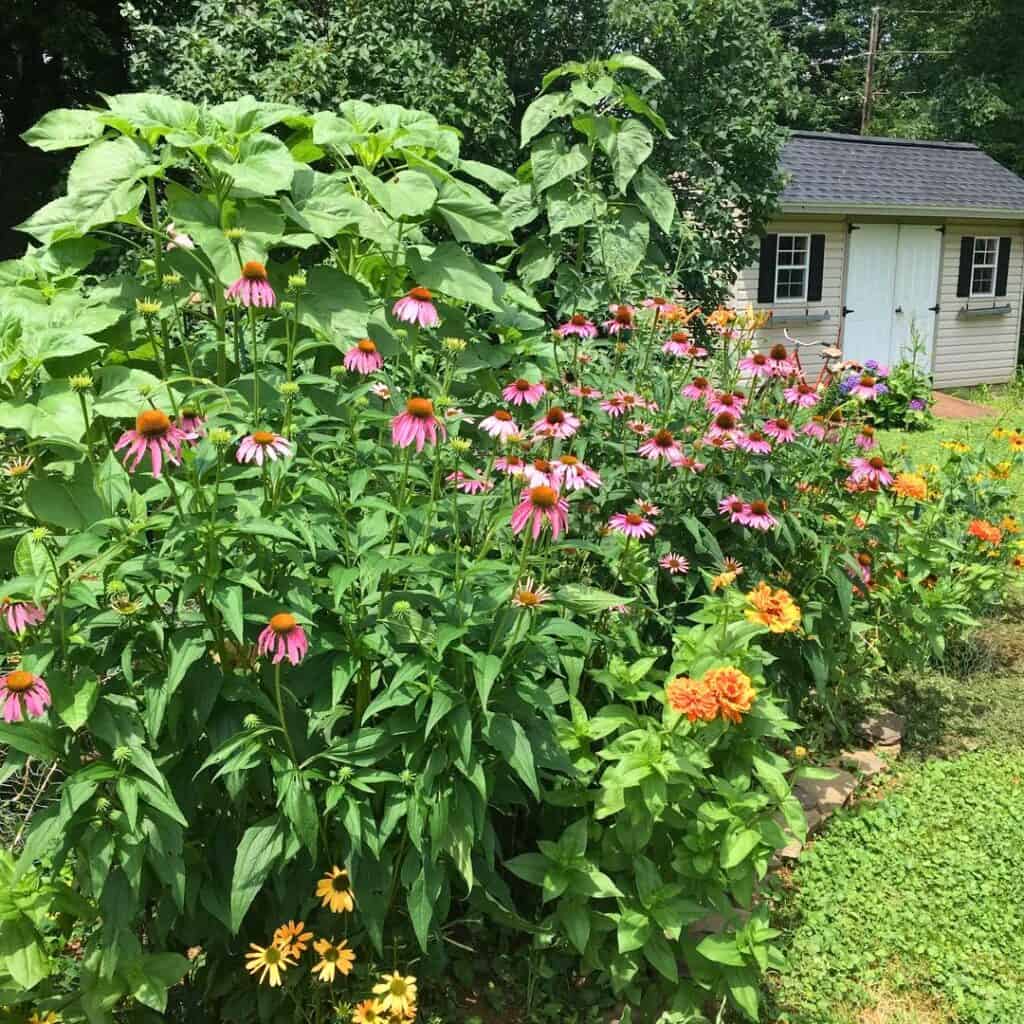
I always try to plant flowers that attract bees near my full sun flower bed. Bees are the best little helpers when it comes to pollination and keeping my garden full and healthy.
Some of my favorites are lavender, coneflowers, and black-eyed Susans. They bloom for ages and give bees plenty of nectar.
Whenever those flowers are in bloom, my garden is buzzing with activity. I like to group the same flowers together because bees prefer clusters of color over single scattered plants.
It’s a bonus that this makes the bed look more organized and colorful, too. I steer clear of pesticides or sprays that could harm bees.
Instead, I stick to natural ways to handle pests. Keeping things safe for bees means they’ll keep coming back and pollinating all season.
A little shallow water dish with pebbles nearby gives bees a safe place to drink. I keep it topped up on hot days so they can rest and recharge.
When I plan out the garden, I pick plants that bloom at different times. That way, there’s always something for bees to eat from spring through fall.
It keeps my yard colorful, too. By including bee-friendly plants, I’m helping pollination and supporting the local ecosystem.
Healthy bee populations mean stronger gardens and more vibrant flowers. It’s a win-win for my yard and the environment.
13) Install a rustic wooden fence behind the bed
There’s just something about a rustic wooden fence that makes a flower bed feel cozy and grounded. The natural wood sets off the colors of the flowers so well, and honestly, the texture just fits with the outdoors.
When I put up my fence, I went with untreated cedar—it weathers in a way I really like, and it’s sturdy. I left the boards a bit uneven for that laid-back, country vibe. It’s a look that feels right at home in a sunny front yard, don’t you think?
A fence can really define the garden area too. It draws a clear line between your flowers and the rest of the yard, which somehow makes everything look more put-together, even if your plants are a bit wild.
I’m a fan of planting tall flowers—sunflowers, hollyhocks, that sort of thing—right up against the fence. They stand out against the wood, and the whole scene just has more depth.
For upkeep, I give the fence a coat of light wood sealant once a year. It keeps the wood from getting beat up by the weather but doesn’t take away from that rustic charm. A quick scrub with a brush and mild soap now and then helps it keep its color, more or less.
Adding little decorative touches is fun too. Sometimes I’ll hang a planter or a quirky metal sign—those small details make the space feel lived-in and personal.
If privacy is your thing, I’d use closely spaced boards or add climbing plants like morning glories or clematis. They grow fast and soften the fence, so it feels peaceful and green.
A rustic fence just works with so many flower bed styles—cottage, modern, whatever you’re into. It’s not hard to build, doesn’t cost a fortune, and has a big impact on curb appeal. For me, it’s one of the easiest ways to make a sunny bed pop.
14) Plant dwarf sunflower varieties for small spaces
I’m a big fan of dwarf sunflowers when I need a splash of color in a small area. These little guys only get about one to three feet tall, so they fit nicely in tight beds or even pots. They’ve got all the cheerfulness of the big ones—just, you know, smaller.
I like tucking them along walkways or near the porch. Their shorter height keeps things open and lets you see what’s behind them, which is a nice bonus. Dwarf varieties let you layer plants without blocking the sunlight.
A few of my favorites: ‘Teddy Bear,’ ‘Little Becka,’ and ‘Sunny Smile.’ Each has its own twist on color and bloom size. Mixing a couple of varieties together looks more natural and colorful, at least in my opinion.
They do best in full sun with well-drained soil. I try to keep up with watering, especially when it’s hot out, since those smaller roots dry out fast.
I also love them in pots or raised beds. You can move them around or brighten up a patio with just a few containers. Not bad for something so compact.
When planting, I leave about six to eight inches between seedlings. They need the space to get sturdy stems and full blooms. Sometimes I’ll toss on a bit of mulch to help keep the soil moist and the weeds down.
Deadheading—snipping off faded blooms—really helps them keep going. I try to remember to do this every week or two once they start flowering.
Dwarf sunflowers are great for attracting pollinators like bees and butterflies. It’s always nice to see a little more life in the garden when they’re blooming.
They’re easy to care for and just as rewarding as the tall types, but they fit anywhere. If you’re working with a small yard or limited space, dwarf sunflowers are a simple way to bring in some sunshine.
15) Add a bench nearby for a relaxing spot

There’s something special about a bench near the flower bed—it turns the garden into a place to linger, not just look. I love having a quiet spot to sit and take it all in, even if it’s just for a few minutes.
When I pick out a bench, I try to match it with the rest of the yard. A wooden bench feels warm and natural, while a metal one is a bit more modern and stands up to the sun. Comfort matters too—I want to actually use it, not just look at it.
I like to set the bench where I can see the brightest flowers but still catch a bit of shade. Sitting out there in the afternoon, listening to bees or birds, is honestly one of my favorite things.
Sometimes I’ll toss on a small cushion or add a side table for a drink or a book. Those little extras make the spot feel more inviting.
A bench also encourages friends to stop and enjoy the garden with you. People tend to sit for a chat and admire the flowers, which makes the yard feel friendlier.
I try to keep the area around the bench tidy. A couple of potted plants or a short border of flowers helps frame the space and makes it pop.
Even a simple bench can totally change how you experience your garden. It’s a reminder to slow down and enjoy what you’ve created. A bench really does turn a flower bed into a peaceful retreat.
How to Prepare Your Front Yard for Full Sun Flower Beds

Before I plant, I check that my front yard has healthy soil, good sunlight, and decent drainage. These basics help flowers put down strong roots and bloom all season.
Soil Preparation Tips
I usually start by testing the soil with a home kit to see where I’m at with pH and nutrients. Most full sun flowers like it a bit acidic to neutral—pH 6.0–7.0 is the sweet spot.
If my soil feels heavy or sticky, I mix in compost, peat moss, or coarse sand to loosen things up. That helps with airflow and root growth. Sandy soil? I’ll add organic matter to hold onto moisture.
I always clear out weeds, rocks, and old roots before planting. The cleaner the bed, the easier it is for flowers to spread out. After planting, I put down a thin layer of mulch to keep things cool and slow down water loss.
| Soil Type | What to Add | Benefit |
|---|---|---|
| Clay | Compost, sand | Better drainage |
| Sandy | Organic matter | Holds moisture |
| Loamy | Light compost | Balanced nutrients |
Choosing the Right Location
I look for spots with at least 6–8 hours of direct sunlight each day. Too much shade, and you end up with floppy stems and fewer blooms.
I try to avoid planting near big trees or tall shrubs that throw a lot of shade. Watching how the sun moves during the day helps me pick the sunniest spot.
If the area gets blasted with afternoon sun, I’ll go for heat-lovers like zinnias, marigolds, or lantanas. Cooler spots? Coreopsis or black-eyed susans handle it well.
I make sure the bed has room for growth and is easy to reach for watering or weeding. A well-placed bed makes the whole yard look more colorful without blocking paths.
Watering and Drainage Considerations
I always check drainage by digging a hole and filling it with water. If it takes more than an hour to drain, I know I need to improve drainage.
To fix slow drainage, I mix in gravel or coarse sand and sometimes raise the bed a bit. It’s a simple way to avoid root rot and soggy soil.
I water deeply but not too often, so roots grow down instead of staying near the surface. Early mornings are best for watering—less evaporation, and the plants have all day to dry off.
For really hot spots, I use drip irrigation or soaker hoses. They get water right to the roots and keep the leaves dry, which helps prevent disease.
Design Tips for a Vibrant Full Sun Flower Bed
When I’m planning a flower bed for full sun, I focus on color balance, plant structure, and seasonal variety. These choices keep things lively and interesting, and honestly, it makes maintenance less of a chore.
Color Coordination Strategies
I usually pick a color palette that works with my house. Warm reds, oranges, and yellows bring energy, while purples and blues feel more relaxed. Mixing both seems to keep things balanced.
To keep the bed from looking too chaotic, I group flowers by color family. Marigolds and zinnias together for a burst of warmth, then maybe some salvia or lavender nearby for contrast.
Here’s a quick way I organize colors:
| Color Type | Example Flowers | Effect |
|---|---|---|
| Warm | Marigolds, Zinnias, Coreopsis | Bright and bold |
| Cool | Salvia, Veronica, Lavender | Calming and soft |
| Neutral | White Alyssum, Dusty Miller | Balances strong colors |
Repeating colors in small patches helps create flow and avoids those weird empty spots.
Incorporating Height and Texture
I like to layer plants by height—tall ones like sunflowers or hollyhocks in the back, medium ones like coneflowers in the middle, and low growers like lantana or verbena up front.
Mixing up texture makes a big difference too. Fine leaves like lavender next to broader foliage like hostas just look more interesting.
Before planting, I double-check spacing. Overcrowding blocks sun and airflow, and nobody wants that. A few inches between plants gives everyone room to thrive.
Seasonal Interest Planning
To keep color going as long as I can, I stagger bloom times. Early bloomers like tulips or dianthus, then mid-season stuff like black-eyed Susans, and finally late bloomers like asters or sedum.
I add a few evergreens or decorative grasses for structure, so the bed doesn’t look empty in winter.
A simple chart helps me keep track:
| Season | Example Plants |
|---|---|
| Spring | Tulips, Dianthus |
| Summer | Zinnias, Black-eyed Susans |
| Fall | Asters, Sedum |
That way, there’s always something happening out there.
Frequently Asked Questions
I love growing flowers that can handle bright sun and still look good. For me, it’s about picking tough, colorful plants, getting the right soil, and mixing up annuals and perennials so there’s always something blooming.
What are some low-maintenance flowers that thrive in full sun?
I’d go with marigolds, zinnias, and blanket flowers. They bloom for months and don’t need much fussing over.
Can you suggest perennials that are perfect for a sunny front yard garden?
Purple coneflowers, black-eyed Susans, and coreopsis are my go-to picks. They come back every year and don’t mind the heat.
How do I design a flower bed for a front yard with full sun exposure?
I like curving the edges of my beds to soften things up. Then I put tall sunflowers in the back, medium flowers like coneflowers in the middle, and short marigolds up front.
What are the best annuals to plant in a sunny front yard flower bed?
Sunflowers, petunias, and cosmos are great for fast color. They fill in quickly and make the yard look cheerful right away.
How can I ensure my full sun flower bed has blooms all season long?
I mix up early, mid, and late-blooming plants so there’s always something flowering. Deadheading faded blooms helps keep the show going, too.
What soil preparation is needed for a successful full sun flower garden?
I usually loosen the soil to around 8–10 inches deep—it’s a bit of a workout, but totally worth it. Mixing in some compost really helps with drainage.
That way, roots can spread out and the plants tend to handle those hot, sunny days a lot better. Honestly, healthy soil just makes everything easier.
Recommended Garden Supplies
| Product Image | Our Recommended Gardening Supplies | Check Offers! |
|---|---|---|
Top Top
Top
Top
Top
Top
Top
Top
Top | rePotme Houseplant and Tropical Classic Potting Soil Mix | Check Offer On Amazon |
 Top
Top
Top
Top
Top
Top
Top
Top | Espoma Organic Indoor Plant Food | Check Offer On Amazon |
 Top
Top
Top
Top
Top
Top
Top
Top | GooingTop LED Grow Light 6000K Full Spectrum Clip Plant Growing Lamp | Check Offer On Amazon |
 Top
Top
Top
Top
Top
Top
Top
Top | Soil Moisture Meter | Check Offer On Amazon |
 Top
Top
Top
Top
Top
Top
Top
Top | Govee Hygrometer Thermometer, Bluetooth Enabled! | Check Offer On Amazon |
 Top
Top | LEVOIT Humidifiers for Large Room(Best For Plants) | Check Offer On Amazon |
 Top
Top
Top
Top
Top
Top
Top
Top | Upgraded DIY Automatic Drip Irrigation Kit, 15 Potted Houseplants Support | Check Offer On Amazon |
 Top
Top
Top
Top
Top
Top
Top
Top | Stainless Steel Heavy Duty Gardening Tool Set | Check Offer On Amazon |
 Top
Top
Top
Top
Top
Top
Top
Top | Bonide Insecticidal Soap | Check Offer On Amazon |
 Top
Top
Top
Top
Top
Top
Top
Top | Bonide 32 oz Spray Neem Oil for Organic Gardening | Check Offer On Amazon |
 Top
Top
Top
Top
Top
Top
Top
Top | Garden Safe Fungicide | Check Offer On Amazon |
Note: Some images in the articles are sourced from Reddit and Other Platforms For Reference Purpose.

